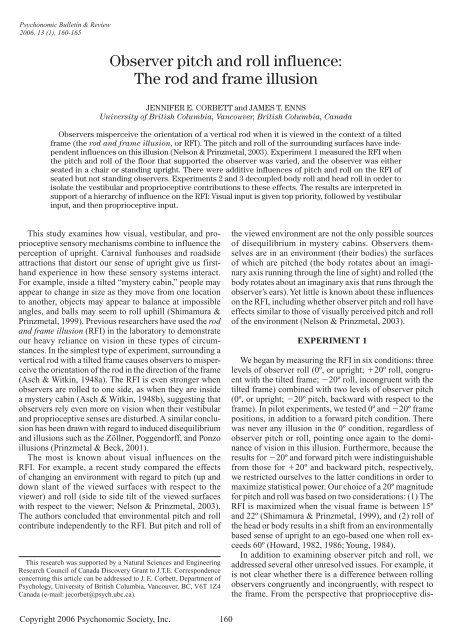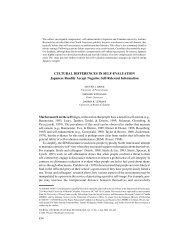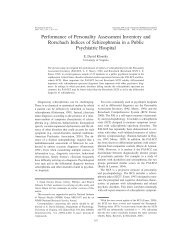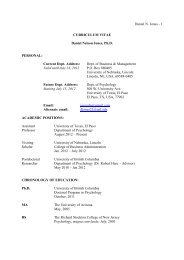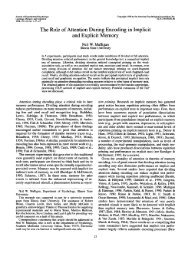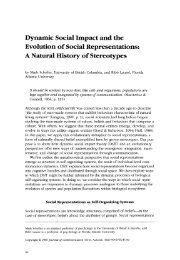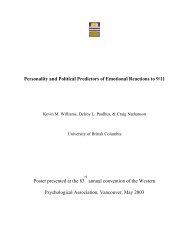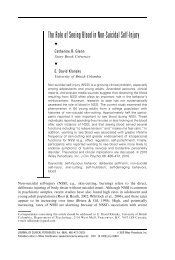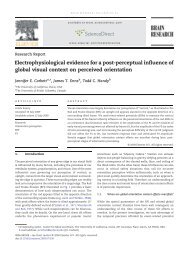Observer pitch and roll influence: The rod and frame ... - ResearchGate
Observer pitch and roll influence: The rod and frame ... - ResearchGate
Observer pitch and roll influence: The rod and frame ... - ResearchGate
You also want an ePaper? Increase the reach of your titles
YUMPU automatically turns print PDFs into web optimized ePapers that Google loves.
Journal Psychonomic Bulletin & Review<br />
2006, ?? 13 (?), (1), ???-??? 160-165<br />
<strong>Observer</strong> <strong>pitch</strong> <strong>and</strong> <strong>roll</strong> <strong>influence</strong>:<br />
<strong>The</strong> <strong>rod</strong> <strong>and</strong> <strong>frame</strong> illusion<br />
JENNIFER E. CORBETT <strong>and</strong> JAMES T. ENNS<br />
University of British Columbia, Vancouver, British Columbia, Canada<br />
<strong>Observer</strong>s misperceive the orientation of a vertical <strong>rod</strong> when it is viewed in the context of a tilted<br />
<strong>frame</strong> (the <strong>rod</strong> <strong>and</strong> <strong>frame</strong> illusion, or RFI). <strong>The</strong> <strong>pitch</strong> <strong>and</strong> <strong>roll</strong> of the surrounding surfaces have independent<br />
<strong>influence</strong>s on this illusion (Nelson & Prinzmetal, 2003). Experiment 1 measured the RFI when<br />
the <strong>pitch</strong> <strong>and</strong> <strong>roll</strong> of the floor that supported the observer was varied, <strong>and</strong> the observer was either<br />
seated in a chair or st<strong>and</strong>ing upright. <strong>The</strong>re were additive <strong>influence</strong>s of <strong>pitch</strong> <strong>and</strong> <strong>roll</strong> on the RFI of<br />
seated but not st<strong>and</strong>ing observers. Experiments 2 <strong>and</strong> 3 decoupled body <strong>roll</strong> <strong>and</strong> head <strong>roll</strong> in order to<br />
isolate the vestibular <strong>and</strong> proprioceptive contributions to these effects. <strong>The</strong> results are interpreted in<br />
support of a hierarchy of <strong>influence</strong> on the RFI: Visual input is given top priority, followed by vestibular<br />
input, <strong>and</strong> then proprioceptive input.<br />
This study examines how visual, vestibular, <strong>and</strong> proprioceptive<br />
sensory mechanisms combine to <strong>influence</strong> the<br />
perception of upright. Carnival funhouses <strong>and</strong> roadside<br />
attractions that distort our sense of upright give us firsth<strong>and</strong><br />
experience in how these sensory systems interact.<br />
For example, inside a tilted “mystery cabin,” people may<br />
appear to change in size as they move from one location<br />
to another, objects may appear to balance at impossible<br />
angles, <strong>and</strong> balls may seem to <strong>roll</strong> uphill (Shimamura &<br />
Prinzmetal, 1999). Previous researchers have used the <strong>rod</strong><br />
<strong>and</strong> <strong>frame</strong> illusion (RFI) in the laboratory to demonstrate<br />
our heavy reliance on vision in these types of circumstances.<br />
In the simplest type of experiment, surrounding a<br />
vertical <strong>rod</strong> with a tilted <strong>frame</strong> causes observers to misperceive<br />
the orientation of the <strong>rod</strong> in the direction of the <strong>frame</strong><br />
(Asch & Witkin, 1948a). <strong>The</strong> RFI is even stronger when<br />
observers are <strong>roll</strong>ed to one side, as when they are inside<br />
a mystery cabin (Asch & Witkin, 1948b), suggesting that<br />
observers rely even more on vision when their vestibular<br />
<strong>and</strong> proprioceptive senses are disturbed. A similar conclusion<br />
has been drawn with regard to induced disequilibrium<br />
<strong>and</strong> illusions such as the Zöllner, Poggendorff, <strong>and</strong> Ponzo<br />
illusions (Prinzmetal & Beck, 2001).<br />
<strong>The</strong> most is known about visual <strong>influence</strong>s on the<br />
RFI. For example, a recent study compared the effects<br />
of changing an environment with regard to <strong>pitch</strong> (up <strong>and</strong><br />
down slant of the viewed surfaces with respect to the<br />
viewer) <strong>and</strong> <strong>roll</strong> (side to side tilt of the viewed surfaces<br />
with respect to the viewer; Nelson & Prinzmetal, 2003).<br />
<strong>The</strong> authors concluded that environmental <strong>pitch</strong> <strong>and</strong> <strong>roll</strong><br />
contribute independently to the RFI. But <strong>pitch</strong> <strong>and</strong> <strong>roll</strong> of<br />
This research was supported by a Natural Sciences <strong>and</strong> Engineering<br />
Research Council of Canada Discovery Grant to J.T.E. Correspondence<br />
concerning this article can be addressed to J. E. Corbett, Department of<br />
Psychology, University of British Columbia, Vancouver, BC, V6T 1Z4<br />
Canada (e-mail: jecorbet@psych.ubc.ca).<br />
the viewed environment are not the only possible sources<br />
of disequilibrium in mystery cabins. <strong>Observer</strong>s themselves<br />
are in an environment (their bodies) the surfaces<br />
of which are <strong>pitch</strong>ed (the body rotates about an imaginary<br />
axis running through the line of sight) <strong>and</strong> <strong>roll</strong>ed (the<br />
body rotates about an imaginary axis that runs through the<br />
observer’s ears). Yet little is known about these <strong>influence</strong>s<br />
on the RFI, including whether observer <strong>pitch</strong> <strong>and</strong> <strong>roll</strong> have<br />
effects similar to those of visually perceived <strong>pitch</strong> <strong>and</strong> <strong>roll</strong><br />
of the environment (Nelson & Prinzmetal, 2003).<br />
EXPERIMENT 1<br />
We began by measuring the RFI in six conditions: three<br />
levels of observer <strong>roll</strong> (0º, or upright; 20º <strong>roll</strong>, congruent<br />
with the tilted <strong>frame</strong>; 20º <strong>roll</strong>, incongruent with the<br />
tilted <strong>frame</strong>) combined with two levels of observer <strong>pitch</strong><br />
(0º, or upright; 20º <strong>pitch</strong>, backward with respect to the<br />
<strong>frame</strong>). In pilot experiments, we tested 0º <strong>and</strong> 20º <strong>frame</strong><br />
positions, in addition to a forward <strong>pitch</strong> condition. <strong>The</strong>re<br />
was never any illusion in the 0º condition, regardless of<br />
observer <strong>pitch</strong> or <strong>roll</strong>, pointing once again to the dominance<br />
of vision in this illusion. Furthermore, because the<br />
results for 20º <strong>and</strong> forward <strong>pitch</strong> were indistinguishable<br />
from those for 20º <strong>and</strong> backward <strong>pitch</strong>, respectively,<br />
we restricted ourselves to the latter conditions in order to<br />
maximize statistical power. Our choice of a 20º magnitude<br />
for <strong>pitch</strong> <strong>and</strong> <strong>roll</strong> was based on two considerations: (1) <strong>The</strong><br />
RFI is maximized when the visual <strong>frame</strong> is between 15º<br />
<strong>and</strong> 22º (Shimamura & Prinzmetal, 1999), <strong>and</strong> (2) <strong>roll</strong> of<br />
the head or body results in a shift from an environmentally<br />
based sense of upright to an ego-based one when <strong>roll</strong> exceeds<br />
60º (Howard, 1982, 1986; Young, 1984).<br />
In addition to examining observer <strong>pitch</strong> <strong>and</strong> <strong>roll</strong>, we<br />
addressed several other unresolved issues. For example, it<br />
is not clear whether there is a difference between <strong>roll</strong>ing<br />
observers congruently <strong>and</strong> incongruently, with respect to<br />
the <strong>frame</strong>. From the perspective that proprioceptive dis-<br />
Copyright 2006 Psychonomic Society, Inc. 160
ROD AND FRAME ILLUSION 161<br />
equilibrium heightens the observer’s reliance on vision,<br />
congruent <strong>and</strong> incongruent <strong>roll</strong> should both lead to the<br />
same large RFI. However, Witkin <strong>and</strong> Asch (1948) reported<br />
that observers who were <strong>roll</strong>ed incongruently with<br />
the visual <strong>frame</strong> experienced a larger RFI than did those<br />
who were <strong>roll</strong>ed congruently. However, the mean difference<br />
in observers’ judgments was small <strong>and</strong> not statistically<br />
significant. Furthermore, the observers were sitting<br />
in a chair, <strong>and</strong> the <strong>frame</strong> was viewed in an otherwise dark<br />
room; these two conditions have not been studied systematically.<br />
Importantly, sitting in a chair limits the corrective<br />
actions an observer can make in order to maintain<br />
an upright posture <strong>and</strong> therefore may limit access to the<br />
relevant proprioceptive information. Similarly, viewing<br />
the <strong>frame</strong> in the dark limits the use of other visual references,<br />
such as a visible horizon, that might otherwise be<br />
used to calibrate a sense of upright (Bressan, Garlaschelli,<br />
& Barracano, 2003). To examine the roles played by these<br />
other factors, we tested (1) observer <strong>roll</strong> that was congruent<br />
<strong>and</strong> incongruent with the tilt of the visual <strong>frame</strong>,<br />
(2) seated observers (as in Witkin & Asch, 1948, <strong>and</strong> Asch<br />
& Witkin, 1948b) <strong>and</strong> st<strong>and</strong>ing observers (as in Asch &<br />
Witkin, 1948a), <strong>and</strong> (3) dark viewing (only the <strong>rod</strong> <strong>and</strong><br />
<strong>frame</strong> were illuminated, as in Nelson & Prinzmetal, 2003;<br />
Witkin & Asch, 1948) <strong>and</strong> light viewing (as in Shimamura<br />
& Prinzmetal, 1999).<br />
Gravitational<br />
upright<br />
31 cm<br />
Perceived<br />
upright<br />
Figure 1. Participant’s eye view of the <strong>rod</strong> <strong>and</strong> <strong>frame</strong> apparatus.<br />
<strong>The</strong> <strong>frame</strong> is <strong>roll</strong>ed 20º to create the <strong>rod</strong> <strong>and</strong> <strong>frame</strong> illusion.<br />
When the <strong>rod</strong> is vertical with respect to gravity (0º, solid line), it<br />
appears tilted to observers because their perception of upright<br />
errs in the direction of the tilted <strong>frame</strong> (dashed line).<br />
Method<br />
Participants. Eighteen individuals (10 females <strong>and</strong> 8 males,<br />
18–35 years old) at the University of British Columbia participated<br />
voluntarily in two sessions. Five were undergraduates recruited from<br />
the human subject pool in the Department of Psychology, <strong>and</strong> they<br />
received extra course credit. Thirteen graduate students <strong>and</strong> postdoctoral<br />
fellows were offered refreshments for their participation. All of<br />
the participants had normal or corrected-to-normal vision <strong>and</strong> none<br />
reported visual or proprioceptive disorders.<br />
<strong>The</strong> 13 graduate students <strong>and</strong> postdoctoral fellows participated<br />
in both a light <strong>and</strong> a dark session. However, the five undergraduates<br />
who were initially tested with the room lights on were unavailable<br />
for a second session. <strong>The</strong>refore, 18 observers participated in a first<br />
testing session in the light <strong>and</strong> 13 of those participated in the second<br />
session in the dark, where only the <strong>rod</strong> <strong>and</strong> <strong>frame</strong> were illuminated.<br />
Apparatus. A <strong>rod</strong> <strong>and</strong> <strong>frame</strong> box made of translucent white<br />
Plexiglas (57 cm long 31 cm high 31 cm wide) was used to<br />
induce the RFI, as illustrated in Figure 1. During testing, the <strong>rod</strong><br />
could be rotated 360º, but the square <strong>frame</strong> was fixed at an orientation<br />
of 20º relative to horizontal. A protractor, displayed on a disc<br />
mounted on the rear of the box, <strong>and</strong> visible only to the experimenter,<br />
indicated the <strong>rod</strong>’s deviation from upright (0º). <strong>The</strong> elevation of the<br />
box was adjusted so that it was at eye level when the observers were<br />
seated or st<strong>and</strong>ing. <strong>The</strong> position of the box was adjusted for each<br />
observer so that approximately 5 cm separated the eyes of the observer<br />
from the front edge of the box. <strong>The</strong> observers were supported<br />
either on a level floor (for the no-<strong>roll</strong> <strong>and</strong> no-<strong>pitch</strong> conditions) or<br />
on a 125-cm 2 wooden platform that was slanted 20º, relative to the<br />
floor. This platform could be rotated into positions marked on the<br />
floor in order to create active conditions for <strong>roll</strong> only, <strong>pitch</strong> only, or<br />
combined <strong>pitch</strong> <strong>and</strong> <strong>roll</strong>. A chair was bolted onto the platform for the<br />
passive viewing conditions. <strong>The</strong> platform <strong>and</strong> chair could be rotated<br />
independently to p<strong>rod</strong>uce passive conditions for <strong>roll</strong> only, <strong>pitch</strong> only,<br />
or combined <strong>pitch</strong> <strong>and</strong> <strong>roll</strong>. We note that although <strong>pitch</strong> <strong>and</strong> <strong>roll</strong> were<br />
not fully mechanically independent in this apparatus, the apparatus<br />
did permit variation along each of these two dimensions. <strong>The</strong> participants<br />
wore a patch over one eye, so that all adjustments were made<br />
with their preferred eye.<br />
Procedure. <strong>The</strong> participants peered inside the box <strong>and</strong> instructed<br />
the experimenter to rotate the <strong>rod</strong> until it was “vertical,” defined<br />
as “in line with the pull of gravity.” <strong>The</strong> participants were given a<br />
demonstration of how the <strong>rod</strong> could be rotated before testing began;<br />
testing did not begin until all questions regarding the procedure had<br />
been answered. <strong>The</strong> experimenter was unable to see the <strong>rod</strong> inside<br />
the box <strong>and</strong> could only see the protractor mounted on the rotating<br />
disc. <strong>The</strong> experimenter looked away from the box each time a participant<br />
asked for the disc to be rotated. <strong>The</strong> participants were given<br />
up to 1 min to refine their adjustments on each trial. <strong>The</strong> initial position<br />
of the <strong>rod</strong> alternated from trial to trial, beginning initially to the<br />
far right or far left of vertical.<br />
<strong>The</strong> participants were first tested with the room lights on. Because<br />
there were 5 cm between their eyes <strong>and</strong> the front edge of the box,<br />
there was a possibility for peripheral vision of the room to play a<br />
role. <strong>The</strong> order of postural conditions was r<strong>and</strong>omly determined.<br />
In the active condition, the participants stood on the platform. <strong>The</strong><br />
experimenter, who stood at the other end of the box in order to move<br />
the <strong>rod</strong> according to the instructions of the participant, was able to<br />
make sure that the participant’s body <strong>and</strong> head maintained an upright<br />
position <strong>and</strong> that his or her head did not move away from the box at<br />
any time. In the passive condition, the participants were seated in<br />
a chair that included a headrest to ensure that the head was kept in<br />
consistent orientation with the trunk.<br />
<strong>The</strong> testing session in the dark occurred on a separate day. In this<br />
condition, a small bulb illuminated the interior of the <strong>rod</strong> <strong>and</strong> <strong>frame</strong><br />
box to ensure that the <strong>rod</strong> <strong>and</strong> <strong>frame</strong> were as visible as they were in<br />
the lights-on condition. Each participant adjusted the <strong>rod</strong> a total of<br />
12 times in each session (3 <strong>roll</strong> 2 <strong>pitch</strong> 2 postural conditions).<br />
Results<br />
<strong>The</strong> mean settings (degrees of tilt from vertical) are<br />
shown in Table 1. <strong>The</strong>se data were examined by ANOVA<br />
involving the factors of observer <strong>roll</strong> (none, congruent,<br />
incongruent), observer <strong>pitch</strong> (none, <strong>pitch</strong>ed), postural balance<br />
(active, passive), <strong>and</strong> lighting (light, dark).<br />
Figure 2 illustrates the main findings. First, there was<br />
a significant RFI in both the active <strong>and</strong> passive condi-
162 CORBETT AND ENNS<br />
Table 1<br />
Mean Rod Settings (in Degrees From Vertical) in Experiment 1<br />
<strong>Observer</strong> Roll<br />
None Congruent Incongruent<br />
Pitch M SE M SE M SE<br />
Active <strong>Observer</strong>s—Light (n 18)<br />
None 2.03 0.84 2.67 1.15 1.75 1.21<br />
Backward 1.58 0.95 2.64 1.10 1.92 0.94<br />
Active <strong>Observer</strong>s—Dark (n 13)<br />
None 3.19 0.81 3.54 0.76 3.08 0.92<br />
Backward 3.04 1.00 3.08 0.91 2.50 1.14<br />
Passive <strong>Observer</strong>s—Light (n 18)<br />
None 3.61 0.84 5.39 0.92 0.89 1.09<br />
Backward 1.11 0.98 4.98 1.24 0.31 0.84<br />
Passive <strong>Observer</strong>s—Dark (n 13)<br />
None 2.92 1.10 7.81 1.00 4.15 1.07<br />
Backward 3.62 0.86 5.77 1.19 3.08 0.95<br />
tions: Participants were never able to adjust the <strong>rod</strong> to 0º<br />
of orientation in the context of the tilted visual <strong>frame</strong> (all<br />
p values .01). Second, manipulations of observer <strong>roll</strong><br />
<strong>and</strong> <strong>pitch</strong> each had an <strong>influence</strong> on the RFI for passive observers.<br />
Congruent observer <strong>roll</strong> increased RFI, whereas<br />
incongruent <strong>roll</strong> decreased the illusion, when compared<br />
with the no-<strong>roll</strong> condition. <strong>Observer</strong> <strong>pitch</strong>, on the other<br />
h<strong>and</strong>, decreased the RFI. Third, the <strong>influence</strong>s of observer<br />
<strong>roll</strong> <strong>and</strong> <strong>pitch</strong> were independent, meaning that the effects<br />
of congruent <strong>and</strong> incongruent <strong>roll</strong> were the same, regardless<br />
of whether the observer was <strong>pitch</strong>ed or not. Fourth,<br />
although observers in the active condition were subject<br />
to the RFI, <strong>rod</strong> settings were not <strong>influence</strong>d significantly<br />
by variations in the <strong>roll</strong> or <strong>pitch</strong> of the platform. Fifth,<br />
whether the room lights were on or off had little <strong>influence</strong><br />
on these findings. A single exception concerned the incongruent<br />
<strong>roll</strong> condition for passive observers in the light.<br />
Under these conditions, incongruent <strong>roll</strong> resulted in an<br />
RFI that was even smaller than in the no-<strong>roll</strong> baseline condition.<br />
Otherwise, incongruent <strong>roll</strong> resulted in essentially<br />
the same illusion as did the no-<strong>roll</strong> condition.<br />
<strong>The</strong>se conclusions were supported by ANOVA. A preliminary<br />
analysis of the 13 participants who were tested<br />
both in the light <strong>and</strong> in the dark revealed no significant<br />
main effect of light [F(1,12) 1, MS e 117.282] <strong>and</strong> no<br />
interactions of light activity [F(1,12) 1, MS e <br />
34.756], light <strong>pitch</strong> [F(1,12) 1, MS e 3.548], light <br />
<strong>roll</strong> <strong>pitch</strong> [F(2,24) 2.66, MS e 6.346, p .05], or<br />
light activity <strong>roll</strong> <strong>pitch</strong> [F(2,24) 1.99, MS e <br />
5.267, p .15]. <strong>The</strong> only significant interactions involving<br />
light were light <strong>roll</strong> [F(2,24) 4.786, MS e 4.704,<br />
p .02] <strong>and</strong> light activity <strong>roll</strong> [F(2,24) 5.52, p <br />
.01], which could both be attributed to a decreased illusion<br />
in the incongruent <strong>roll</strong> condition, but only when the participants<br />
were tested under passive postural control in the<br />
light. Under these conditions, the RFI was significantly<br />
smaller than it was in the no-<strong>roll</strong> control conditions<br />
[F(1,24) 9.46, MS e 6.346, p .01].<br />
In order to maximize the statistical power for the consideration<br />
of observer <strong>pitch</strong> <strong>and</strong> <strong>roll</strong>, the remaining analyses<br />
were conducted on the data from all 18 observers<br />
who were tested in the light. This ANOVA revealed significant<br />
interactions of activity <strong>roll</strong> [F(2,34) 6.31,<br />
MS e 9.462, p .01] <strong>and</strong> activity <strong>pitch</strong> [F(1,17) <br />
4.64, MS e 3.126, p .05], but no three-way interaction<br />
of activity <strong>roll</strong> <strong>pitch</strong> [F(2,34) 1, MS e 6.678].<br />
Examination of these interactions indicated that the <strong>influence</strong>s<br />
of observer <strong>roll</strong> <strong>and</strong> <strong>pitch</strong> were significant in the<br />
passive postural condition but not in the active condition<br />
(all ps .20). Simple effects ANOVA in the passive condition<br />
revealed significant main effects of observer <strong>roll</strong><br />
[F(2,34) 19.47, MS e 9.462, p .01] <strong>and</strong> observer<br />
<strong>pitch</strong> [F(1,17) 11.39, MS e 3.126, p .01], but no<br />
interaction of <strong>roll</strong> <strong>pitch</strong> [F(2,34) 1.66, p .20]. <strong>The</strong><br />
main effect of <strong>roll</strong> was subdivided further into a significantly<br />
larger illusion for congruent <strong>roll</strong> than for no <strong>roll</strong><br />
[F(1,34) 8.64, MS e 9.462, p .01] <strong>and</strong> a margin-<br />
Adjusted Rod (degrees)<br />
14<br />
12<br />
10<br />
8<br />
6<br />
4<br />
2<br />
0<br />
Active<br />
<strong>Observer</strong> <strong>roll</strong><br />
0º none<br />
+20º congruent<br />
–20º incongruent<br />
Passive<br />
–2<br />
0º 20º 0º 20º<br />
<strong>Observer</strong> Pitch<br />
<strong>Observer</strong> Pitch<br />
Figure 2. Mean <strong>rod</strong> <strong>and</strong> <strong>frame</strong> illusion in Experiment 1: Influences of <strong>pitch</strong> <strong>and</strong> <strong>roll</strong> of the<br />
floor in active <strong>and</strong> passive observers. Error bars indicate 1 SEM.
ROD AND FRAME ILLUSION 163<br />
ally smaller illusion for incongruent <strong>roll</strong> than for no <strong>roll</strong><br />
[F(1,34) 2.889, MS e 9.462, p .10].<br />
Discussion<br />
<strong>The</strong> main finding was that observer <strong>pitch</strong> <strong>and</strong> <strong>roll</strong> had<br />
independent <strong>influence</strong>s on the RFI when observers were<br />
seated. <strong>The</strong> absence of a statistical interaction under<br />
these conditions is similar to the results of Nelson <strong>and</strong><br />
Prinzmetal (2003), who found that <strong>pitch</strong> <strong>and</strong> <strong>roll</strong> of the<br />
visual environment contributed independently to observers’<br />
estimates of upright, even when observers were stationed<br />
on a flat surface. Together with the present finding,<br />
this suggests that separate mechanisms are at play in the<br />
perception of these two dimensions of space, regardless of<br />
whether they are perceived via visual, vestibular, or proprioceptive<br />
inputs.<br />
Experiment 1 also contributed data to unresolved issues<br />
regarding the RFI. First, on the question of the congruent<br />
versus incongruent observer <strong>roll</strong>, the data are clear in<br />
showing that the largest illusion occurs when observers<br />
are oriented congruently with the <strong>frame</strong>. When observers<br />
are <strong>roll</strong>ed incongruently, the RFI is similar to that measured<br />
when observers are not <strong>roll</strong>ed at all. One explanation<br />
is that the congruent <strong>roll</strong> condition is most similar to<br />
the conditions of everyday viewing, in which the visual<br />
cues in the environment agree with the proprioceptive<br />
cues regarding upright; it is the reliance on visual cues<br />
under these everyday circumstances that contributes to the<br />
large illusion in the congruent experimental conditions.<br />
In contrast, when observers are <strong>roll</strong>ed incongruently with<br />
the <strong>frame</strong>, the discrepancy between these two sources of<br />
information prompts observers to consult their vestibular<br />
<strong>and</strong> proprioceptive signals more carefully, permitting<br />
compensation for the tilted visual <strong>frame</strong>.<br />
Support for this interpretation can be found in the interactions<br />
observed between light, postural activity, <strong>and</strong><br />
observer <strong>roll</strong>. Recall that when observers were tested<br />
in the light, the incongruent <strong>roll</strong> condition resulted in a<br />
smaller RFI than when they were tested in the dark. This<br />
is consistent with observers using proprioception to compensate<br />
for the RFI normally experienced under observer<br />
<strong>roll</strong>. <strong>The</strong>se signals would have greater support in the light<br />
condition, in which the rest of the testing room was partially<br />
visible <strong>and</strong> could be used to calibrate these cues,<br />
than in the dark condition, in which only the <strong>rod</strong> <strong>and</strong> <strong>frame</strong><br />
were visible.<br />
Additional support for the idea that observers were<br />
weighting their visual <strong>and</strong> proprioceptive cues differentially<br />
comes from the small but significant reduction in<br />
the RFI for <strong>pitch</strong>ed observers. When seated observers<br />
adjusted the <strong>rod</strong>, they experienced a smaller visual tilt<br />
illusion than when they were sitting upright. Pitching a<br />
seated person backward (or forward) in a chair gives him<br />
or her additional points of somatosensory contact (back<br />
<strong>and</strong> legs), possibly allowing the individual to read his or<br />
her body position better (including <strong>roll</strong>) than when the<br />
individual is seated upright.<br />
<strong>The</strong> second issue concerns ambient visual lighting. For<br />
the most part, whether or not observers were able to see<br />
the room through peripheral vision had no effect on the<br />
RFI. This means that the stimuli considered “relevant” to<br />
the observer are restricted to the <strong>rod</strong> <strong>and</strong> <strong>frame</strong> apparatus.<br />
<strong>The</strong> one exception to this rule, already mentioned, concerns<br />
passively seated observers who are <strong>roll</strong>ed incongruently<br />
with respect to the tilted <strong>frame</strong>. In this situation, it<br />
appears that peripheral vision helped observers compensate<br />
to some extent for the <strong>roll</strong> of the <strong>frame</strong> by allowing<br />
them to consult their proprioceptive signals relative to<br />
their ambient visual surroundings.<br />
A final issue concerns seated as opposed to st<strong>and</strong>ing<br />
observers. <strong>The</strong> results showed that observers who were actively<br />
maintaining their balance experienced a robust RFI.<br />
However, their illusion was not <strong>influence</strong>d by the <strong>pitch</strong><br />
<strong>and</strong> <strong>roll</strong> of the environment. In contrast, when observers<br />
were seated, variations in observer orientation had a large<br />
<strong>and</strong> significant <strong>influence</strong>. <strong>The</strong>re are at least two explanations<br />
for this difference. First, active observers may have<br />
access to more accurate proprioceptive information than<br />
do passive observers, simply by virtue of the fact that they<br />
must use this information to maintain their balance. If so,<br />
then the reduced effects of observer <strong>pitch</strong> <strong>and</strong> <strong>roll</strong> for active<br />
observers are consistent with the compensation account<br />
already described: Proprioception is weighted more<br />
heavily when it is also being used for the purpose of st<strong>and</strong>ing<br />
upright. An alternative account is that the heads of<br />
active observers remained upright with respect to gravity,<br />
whereas the heads of passive observers were <strong>roll</strong>ed. This<br />
postural adjustment by the active observers may have allowed<br />
them to experience the <strong>rod</strong> <strong>and</strong> <strong>frame</strong> in a way more<br />
similar to the way it is experienced by observers who are<br />
supported on a horizontal surface. We consider this issue<br />
in the next experiments.<br />
EXPERIMENT 2<br />
In Experiment 1, seated observers were <strong>influence</strong>d by<br />
the <strong>pitch</strong> <strong>and</strong> <strong>roll</strong> of the floor, but st<strong>and</strong>ing observers were<br />
not. Yet these conditions differed not only in whether participants<br />
made active postural adjustments; the heads of<br />
st<strong>and</strong>ing observers were upright, whereas those of seated<br />
observers were <strong>roll</strong>ed. This may be important, because<br />
head orientation strongly <strong>influence</strong>s the vestibular sense.<br />
Body balance is dependent, to a large extent, on the semicircular<br />
canals <strong>and</strong> otolith organs of the inner ear (Wilson<br />
& Melvill Jones, 1979). Perhaps the sensitivity to <strong>pitch</strong><br />
<strong>and</strong> <strong>roll</strong> in seated observers occurred because their vestibular<br />
sense of gravity was disrupted. If so, then we should be<br />
able to remove the proprioceptive <strong>influence</strong>s on the RFI by<br />
allowing seated observers to hold their heads upright while<br />
the chair in which they are seated is <strong>pitch</strong>ed <strong>and</strong> <strong>roll</strong>ed.<br />
Alternatively, if the vestibular system is not the principle<br />
sensory mechanism being disrupted by head <strong>and</strong> body <strong>roll</strong>,<br />
we should obtain the same results as in Experiment 1 (passive<br />
condition) even when the head is held upright.<br />
Method<br />
Twelve individuals (6 females <strong>and</strong> 6 males, 18–35 years old) participated<br />
in a procedure identical to that used in the passive condi-
164 CORBETT AND ENNS<br />
tion (light viewing) in Experiment 1, with the exception that the<br />
headrest was removed from the chair <strong>and</strong> all of the participants were<br />
instructed to keep their heads upright during the session. <strong>The</strong> experimenter,<br />
st<strong>and</strong>ing at the other end of the box, was able to make<br />
sure that the participant’s head was maintained in an upright position<br />
using a horizontal reference line on the wall behind the participant.<br />
Results<br />
Figure 3 shows two main findings. First, there was a<br />
significant RFI in each condition of the experiment (all<br />
p values .01) that was similar in magnitude to the RFI<br />
measured in the active condition of Experiment 1 (F 1).<br />
Second, manipulations of observer <strong>roll</strong> <strong>and</strong> <strong>pitch</strong> on seated<br />
observers no longer had any <strong>influence</strong> on the RFI (all F<br />
values for main effects <strong>and</strong> interactions 1).<br />
Discussion<br />
<strong>The</strong> results suggest that the proprioceptive <strong>influence</strong>s<br />
on the RFI observed in Experiment 1 occurred because<br />
the vestibular system was disrupted by <strong>roll</strong>ing the head.<br />
When observers were able to hold their heads upright in<br />
the present experiment, there was still a significant RFI,<br />
but it was no longer <strong>influence</strong>d by the position of the observer’s<br />
body relative to the pull of gravity. In other words,<br />
the results were now indistinguishable from those in the<br />
active condition of Experiment 1, in which observers were<br />
st<strong>and</strong>ing upright on a <strong>pitch</strong>ed <strong>and</strong> <strong>roll</strong>ed platform.<br />
EXPERIMENT 3<br />
As a final step, we asked whether disrupting the vestibular<br />
system alone was sufficient to reinstate the proprioceptive<br />
effects observed in the passive condition of<br />
Experiment 1. We tested this by measuring the RFI while<br />
participants were st<strong>and</strong>ing upright on the <strong>pitch</strong>ed <strong>and</strong><br />
<strong>roll</strong>ed platform, but with the requirement that they <strong>roll</strong><br />
their heads 20º to one side, so their heads would be congruent<br />
with the visual <strong>frame</strong>. If vestibular disruption was<br />
responsible for the proprioceptive <strong>influence</strong>s on the RFI,<br />
Adjusted Rod (degrees)<br />
14<br />
12<br />
10<br />
8<br />
6<br />
4<br />
2<br />
0<br />
–2<br />
<strong>Observer</strong> <strong>roll</strong><br />
0º none<br />
+20º congruent<br />
–20º incongruent<br />
0º 20º<br />
<strong>Observer</strong> Pitch<br />
Figure 3. Mean <strong>rod</strong> <strong>and</strong> <strong>frame</strong> illusion in Experiment 2: Passively<br />
<strong>pitch</strong>ed <strong>and</strong> <strong>roll</strong>ed observers with vertical head orientation.<br />
Error bars indicate 1 SEM.<br />
then this manipulation should reinstate them. Alternatively,<br />
if the combination of body <strong>and</strong> head <strong>roll</strong> was necessary<br />
to cause the proprioceptive <strong>influence</strong>s in Experiment<br />
1, then a simple <strong>roll</strong> of the head should not reveal<br />
any proprioceptive <strong>influence</strong>s.<br />
Method<br />
<strong>The</strong> 12 participants from Experiment 2 were tested in a procedure<br />
identical to that used in the active condition (light viewing) in Experiment<br />
1, with the exception that they aligned their heads with the<br />
tilt of the <strong>frame</strong>. <strong>The</strong> experimenter monitored the head position of all<br />
of the observers relative to a 20º reference line on the wall directly<br />
behind the participants’ heads.<br />
Results<br />
Figure 4 shows two main findings. First, there was a<br />
significant RFI in each condition of the experiment (all p<br />
values .01) that was much larger in magnitude than was<br />
the RFI measured in the active condition in Experiment 1<br />
[F(1,23) 24.60, p .001]. Second, manipulations of<br />
observer <strong>roll</strong> <strong>and</strong> <strong>pitch</strong> on seated observers had no measurable<br />
<strong>influence</strong> on the RFI (all F values for main effects<br />
<strong>and</strong> interactions 1.5, p .24).<br />
Discussion<br />
<strong>The</strong> proprioceptive <strong>influence</strong>s on the RFI observed in<br />
the passive condition of Experiment 1 appear to depend<br />
on both passive seating <strong>and</strong> a <strong>roll</strong>ed head. As we saw in<br />
Experiment 3, simply <strong>roll</strong>ing the observer’s head so that<br />
it was congruent with the visual <strong>frame</strong> was not sufficient<br />
to invoke the proprioceptive <strong>influence</strong>s on the RFI from<br />
the <strong>pitch</strong>ed <strong>and</strong> <strong>roll</strong>ed platform that was supporting the<br />
participants. Experiment 2 showed that passive seating on<br />
a <strong>pitch</strong>ed <strong>and</strong> <strong>roll</strong>ed chair was also not sufficient in itself<br />
to induce these effects. Only when the observer’s head was<br />
<strong>roll</strong>ed (to disrupt the vestibular sense of upright) <strong>and</strong> when<br />
the observer was seated in a chair that was <strong>pitch</strong>ed <strong>and</strong><br />
<strong>roll</strong>ed (to accentuate the proprioceptive inputs concerning<br />
the unusual environment) was the RFI <strong>influence</strong>d by both<br />
the <strong>pitch</strong> <strong>and</strong> <strong>roll</strong> of the floor supporting the observers.<br />
GENERAL DISCUSSION<br />
<strong>The</strong> consistent RFI that was measured in three experiments<br />
points to the large extent to which our perception<br />
of upright depends on vision. This reliance on vision becomes<br />
even stronger when the vestibular sense is disrupted<br />
by the act of <strong>roll</strong>ing one’s head to the side (as demonstrated<br />
in Experiment 3). In contrast, merely <strong>roll</strong>ing one’s<br />
body, without a corresponding <strong>roll</strong> of the head, does not<br />
result in a stronger-than-normal illusion (Experiment 2),<br />
presumably because the vestibular system can still be used<br />
to inform judgments about upright based on an upright<br />
head position. Finally, when both the vestibular system<br />
<strong>and</strong> the proprioceptive sense of upright are disturbed (Experiment<br />
1, passive condition), the visual illusion (RFI)<br />
becomes sensitive to proprioceptive signals regarding<br />
gravitational upright.<br />
This pattern of data suggests a hierarchy of control<br />
signals with regard to the perception of upright. In this
ROD AND FRAME ILLUSION 165<br />
Adjusted Rod (degrees)<br />
14<br />
12<br />
10<br />
8<br />
6<br />
4<br />
2<br />
0<br />
–2<br />
<strong>Observer</strong> <strong>roll</strong><br />
0º none<br />
+20º congruent<br />
–20º incongruent<br />
0º 20º<br />
<strong>Observer</strong> Pitch<br />
Figure 4. Mean <strong>rod</strong> <strong>and</strong> <strong>frame</strong> illusion in Experiment 3: Active<br />
observers with head orientation <strong>roll</strong>ed 20º. Error bars indicate<br />
1 SEM.<br />
hierarchy, vision is the dominant sensory system, providing<br />
an illusion that is never completely overcome under<br />
any circumstance when the larger visual context is a tilted<br />
<strong>frame</strong>. <strong>The</strong> vestibular system has secondary status, in that<br />
it is permitted to modulate the visual input. This is presumably<br />
why the RFI is so large when the head is tilted<br />
<strong>and</strong> why it is reduced by the simple act of holding the head<br />
upright. Finally, the proprioceptive system does contribute<br />
to visual judgments of upright, but only if the vestibular<br />
sense has first become unreliable because of a head position<br />
that is less than vertical.<br />
<strong>The</strong> finding of independent effects of observer <strong>roll</strong> <strong>and</strong><br />
<strong>pitch</strong> in seated observers (Experiment 1) bears a superficial<br />
resemblance to the report that the <strong>pitch</strong> <strong>and</strong> <strong>roll</strong> of<br />
viewed surfaces contribute separately to the RFI (Nelson<br />
& Prinzmetal, 2003). A promising lead for future studies<br />
of this independence is the observation that the vestibular<br />
system (semicircular canals <strong>and</strong> otolith organs) is organized<br />
to permit independent registration of the <strong>pitch</strong> <strong>and</strong><br />
<strong>roll</strong> of the head (Wilson & Melvill Jones, 1979). Along the<br />
same lines, recordings from muscles of the legs <strong>and</strong> trunk<br />
show separate responses to perturbations along the <strong>pitch</strong><br />
<strong>and</strong> <strong>roll</strong> axes of rotation (Carpenter, Allum, & Honegger,<br />
1999). Moreover, vestibular neurons signaling <strong>pitch</strong> <strong>and</strong><br />
<strong>roll</strong> maintain their distinctiveness in the visuomotor areas<br />
of the brain to which they project (Carpenter et al., 1999).<br />
It is therefore possible that functionally separate mechanisms<br />
for the visual perception of <strong>pitch</strong> <strong>and</strong> <strong>roll</strong> may have<br />
come about, in an evolutionary sense, from their connection<br />
to the more primitive vestibular <strong>and</strong> proprioceptive<br />
systems from which they emerged. If so, this suggests that<br />
future research will continue to find independent mechanisms<br />
for the perception of <strong>pitch</strong> <strong>and</strong> <strong>roll</strong>, regardless of the<br />
sensory system being studied.<br />
REFERENCES<br />
Asch, S. E., & Witkin, H. A. (1948a). Studies in space orientation: I. Perception<br />
of the upright with displaced visual fields. Journal of Experimental<br />
Psychology, 38, 325-337.<br />
Asch, S. E., & Witkin, H. A. (1948b). Studies in space orientation: II. Perception<br />
of the upright with displaced visual fields <strong>and</strong> with body tilted.<br />
Journal of Experimental Psychology, 38, 455-477.<br />
Bressan, P., Garlaschelli, L., & Barracano, M. (2003). Antigravity<br />
hills are visual illusions. Psychological Science, 14, 441-449.<br />
Carpenter, M. G., Allum, J. H. J., & Honegger, F. (1999). Directional<br />
sensitivity of stretch reflexes <strong>and</strong> balance corrections for normal<br />
subjects in the <strong>roll</strong> <strong>and</strong> <strong>pitch</strong> planes. Experimental Brain Research,<br />
129, 93-113.<br />
Howard, I. P. (1982). Human visual orientation. New York: Wiley.<br />
Howard, I. P. (1986). <strong>The</strong> perception of posture, self motion, <strong>and</strong> the visual<br />
vertical. In K. R. Boff, L. Kaufman, & J. P. Thomas (Eds.), H<strong>and</strong>book<br />
of perception <strong>and</strong> human performance: Vol. 1. Sensory processes<br />
<strong>and</strong> perception (pp. 18.1-18.62). New York: Wiley.<br />
Nelson, R., & Prinzmetal, W. (2003). On the relation between <strong>roll</strong> <strong>and</strong><br />
<strong>pitch</strong>. Visual Cognition, 10, 715-728.<br />
Prinzmetal, W., & Beck, D. M. (2001). <strong>The</strong> tilt-consistency theory of<br />
visual illusions. Journal of Experimental Psychology: Human Perception<br />
& Performance, 27, 206-217.<br />
Shimamura, A. P., & Prinzmetal, W. (1999). <strong>The</strong> Mystery Spot illusion<br />
<strong>and</strong> its relation to other visual illusions. Psychological Science,<br />
10, 501-507.<br />
Wilson, V. J., & Melvill Jones, G. (1979). Mammalian vestibular<br />
physiology. New York: Plenum.<br />
Witkin, H. A., & Asch, S. E. (1948). Studies in space orientation: IV. Further<br />
experiments on perception of the upright with displaced visual<br />
fields. Journal of Experimental Psychology, 38, 762-782.<br />
Young, L. R. (1984). Perception of the body in space: Mechanisms. In<br />
J. M. Brookhart & V. B. Mountcastle (Section Eds.) & I. Darian-Smith<br />
(Vol. Ed.), H<strong>and</strong>book of physiology: Section 1. <strong>The</strong> nervous system:<br />
Vol. 3. Sensory processes (pp. 1023-1066). Bethesda, MD: American<br />
Physiological Society.<br />
(Manuscript received October 3, 2004;<br />
revision accepted for publication June 12, 2005.)


